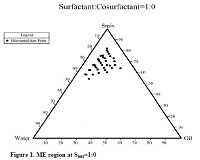Effect of Penetration Enhancer DMSO on In-Vitro Skin Permeation of Acyclovir Transdermal Microemulsion Formulation
Keywords:
DMSO, Penetration enhancer, Ethanol, Transdermal Microemulsion, Acyclovir (ACV)Abstract
The aim of this research was to enhance the flux of transdermal drug delivery by using penetration enhancers DMSO. Skin penetration enhancers have been used to improve bioavailability and increase the range of drugs for which topical and transdermal delivery is a viable option which penetrate into skin to reversibly decrease the barrier resistance. Penetration enhancing activity of dimethylsulphoxide (DMSO) at 5% w/w and 10% w/w concentration were determined in aqueous solution of ACV and in microemulsion formulations though calculation of transdermal flux of ACV with Keshary Chein Frenz Diffusion cell by using wistar albino rat skin. The transdermal flux of formulations PD, PD5D, PD10D, ME1 and ME10D was found to be 2.47, 50.7529, 119.7691, 238.1432 and 266.6721µg/cm2/h. The flux of microemulsion formulation ME10D was found 266.6721± 8.49 µg/cm2/h. Which showed highest value and skin flux of the drug could be enhanced up to 107 fold compared to its aqueous solution by preparing microemulsion ME10D. DMSO in microemulsion formulation is safe to the skin at 10% DMSO w/w. Keywords: DMSO, Penetration enhancer, Ethanol, Transdermal Microemulsion, Acyclovir (ACV)
References
AC, Barry BW. Penetration
, Iglesias-Vilas G, BlancoThe significant difference in acyclovir
permeation between microemulsion formulations,
PD and ME10D was probably due to the mean
size of internal phase droplets, which were
significantly smaller in microemulsions and
effect of DMSO penetration enhancer.
Conlusion
We have show
penetration enhancer for the transdermal delivery
of ACV and skin flux of the drug could be
enhanced up to 107 fold compared to its aqueous
solution. Increased percentage of DMSO 10% as
compared to 5% in aqueous solution enhanced
transdermal flux 2.36 fold greater. The skin flux
of the drug is dependent on the concentration of
water, DMSO and ethanol in microemulsion.
Microemulsion is safe to the skin at 10% DMSO
w/w.
Ackn
Authors are great thankfu
Pharmacy, Bundelkhand university Jhansi, (UP)
India, for providing guidance, laboratories and
animal facilities. Authors are great thankful to
Cipla Ltd, Mumbai, for providing Acyclovir as
free gift sample. Authors are also thankful to
NICAIR Delhi and AIIMS New Delhi for
literature survey and TEM facilities.
eferences R
. Williams
enhancers; Advanced Drug Delivery Reviews
; 56: 603-618.
Delgado-Charro MB
Me´ndez J. Delivery of a hydrophilic solute
though the skin from novel microemulsion
systems. Eur. J. Pharm. Biopharm1997; 43:
–42.
Ktistis G, Niopas I. A study on the in-vitro
percutaneous absorption of Propranolol from
disperse systems. J. Pharm. Pharmacol 1998;
: 413–418.
Kreilgaard M. I
Dannielsson I, Lindman B. The definition of
microemulsion; Colloids and Surfaces 1981;
: 391-392.
nfluence of microemulsions on
cutaneous drug delivery; Advanced Drug
Delivery Reviews 2002;54 Suppl. 1: S77–S98.
n for topical administration of
ydro-micelle. Nature 1943; 152:
ulsions by electron microscopy, J.
al Permeation of Hydrocortisone
f Aceclofenac. AAPS
elivery of aspirin;
water, propylene glycol,
El-laithy HM, El-shoboury KMF. The
developmental cutina lipogel and gel
microemulsio
fluconazole. AAPS. Pharm. Sci. Tech 2002;3
(4) 35: 1-9.
Hoar TP, Schulman JH. Microemulsion.
Transparent water-in-oil dispersions: the
oleopathic h
-103.
Schulman JH, Stoeckenius W, Prince LM.
Mechanism of formation and structure of
micro em
Phys. Chem. 63 (1959) 1677–1680.
Tenjarla S., Microemulsios: An overview and
Pharmaceutical applications. Crit. Rev.
Therapeutic Drug Carrier Systems 1999; 16:
-521.
Fini A, Bergamante V, Ceschel GC, Ronchi C,
Alberto C, Moraes FD. Control of
Transderm
Acetate from Hydrophilic and Lipophilic
Formulations. AAPS Pharm SciTech 2008;
Vol. 9: No. 3, 762-768.
Shakeel F, Baboota S, Ahuja A, Khar RK, Ali
M, Shafiq S. Nanoemulsions as Vehicles for
Transdermal Delivery o
Pharm SciTech 2007; 8 (4) Article 104: E1-E9
Gaitonde CD, Gui Z, Qu A, Anik S, Flack M,
Vengroff. Merthod Validation for particle size
distribution of nanoemulsion using Photon
Correlation Spectroscopy. Nano Bio
Corporation2008; 27, 1-5.
Ammar HO, Ghorab M, El-Nahhas SA, Kamel
R. Evaluation of chemical penetration
enhancers for transdermal d
Asian Journal of Pharmaceutical Sciences
; 2 (3): 96-105.
Panchagnula R, Salve PS, Thomas NS, Jain
AK., Ramarao P. Transdermal delivery of
naloxone: effect of
ethanol and their binary combinations on
permeation though rat skin.International
Journal of Pharmaceutics 2001; 219: 95–105





